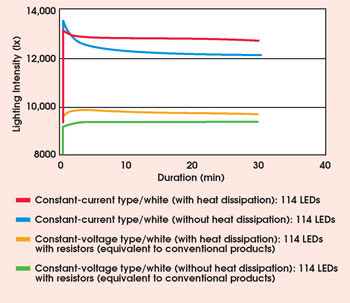Kevin Sebley, Moritex USA Inc.
There is no question that LED lighting is continuing to make inroads into the machine vision market, mainly because the technology’s strengths outweigh its inherent weaknesses in a variety of general applications. Because of the compactness of individual LED elements, the space needed for a lighting system can be much smaller. Other benefits include less power consumption, extremely good control of bandwidth and no deterioration of the light output during conventional operation.
In a typical application, such as inspection of chip components and printed circuit boards, LED illumination is sufficient for checking the alignment of components, as well as for providing enough contrast to inspect for solder and other related defects.
LED sources are available in many configurations. For example, in ringlighting used in front-ring illumination bright-field strategies, they can provide 360° of intense, shadow-free, even (nondirectional) illumination, except, perhaps, when working with highly reflective surfaces. They are also available in backlight, coaxial and bar-light configurations.
LED lighting is still not an option for applications that require long working distances, especially line-scan applications, which can have fairly large targets as well. In this case, the technology’s inherent weakness continues to be lack of brightness compared with other sources of light. The working distance limitation is slowly being reduced with efforts to introduce ever-brighter devices. However, the cost of current high-brightness technology is still too high to justify the use of such LEDs in many traditional machine vision applications.
Heat control
An area where LED illumination has seen major advances is heat control. With conventional LED lighting, the heat factor still cannot be separated from the luminous intensity. In general, LEDs generate heat that reduces device luminosity as it builds up. Although heating may not be as much of a concern when LEDs are run at less than full power, most machine vision applications do require them to operate at full power to get the desired brightness.
Paradoxically, in a constant-voltage system, any kind of heat dissipation will require LEDs to have a heat-generation-limiting resistor. Emerging LED technology — Moritex’s MG-Wave series, for example — resolves this problem by using a constant-current-detection control system. Relocating the heat-generation-limiting resistor from inside the light to the power source improves control of heat emission, removing any adverse impact that a resistor would have on thermal characteristics.
Combination strategy
With a limiting resistor incorporated into the light, a constant voltage configuration can be applied to any light within the capacity of the power supply. Although this configuration alone is highly effective in controlling heat, it requires an adjustment to the supply current of the power source based on the number of diodes (i.e., the total current required). This means not only that each light requires an independent power source, but also that the system is not very flexible in altering the conditions, such as when changing the light.
With a detection circuit incorporated into the light, the latest generation of LED heat-control systems reads the resulting signal to control the rated current. The information is adjusted according to the number of LEDs in the lighting module, which allows the strategy to work with any type of lighting — such as in the constant-voltage configuration — if it is within the maximum current capacity of the power source.
Test results show that use of a constant-current system in combination with this proprietary heat-dissipation technology reduces heat generation, while providing as much as 40 percent more luminous intensity than conventional LED products (see figure).

Lighting intensity measurements for four test products illustrate the impact of moving the resistor to the power source. The tests were for 30 minutes of lighting after full acclimatization to the temperature of a bath maintained at a constant 40 °C.
In general, this illumination strategy can produce more-stable images for a longer period than other forms of lighting because repeatedly switching the light on and off causes no deterioration. With LEDs operating across a narrow bandwidth, it also is easier to acquire the contrast that is needed for diverse image processing applications.
Continous improvements in brightness levels and heat control are making LED lighting a strong contender in many applications. However, the technology still has weaknesses that preclude its use in certain applications, such as those that require long working distances.
Meet the author
Kevin Sebley is sales and business development manager for Moritex USA Inc. in San Jose, Calif.; e-mail: [email protected].